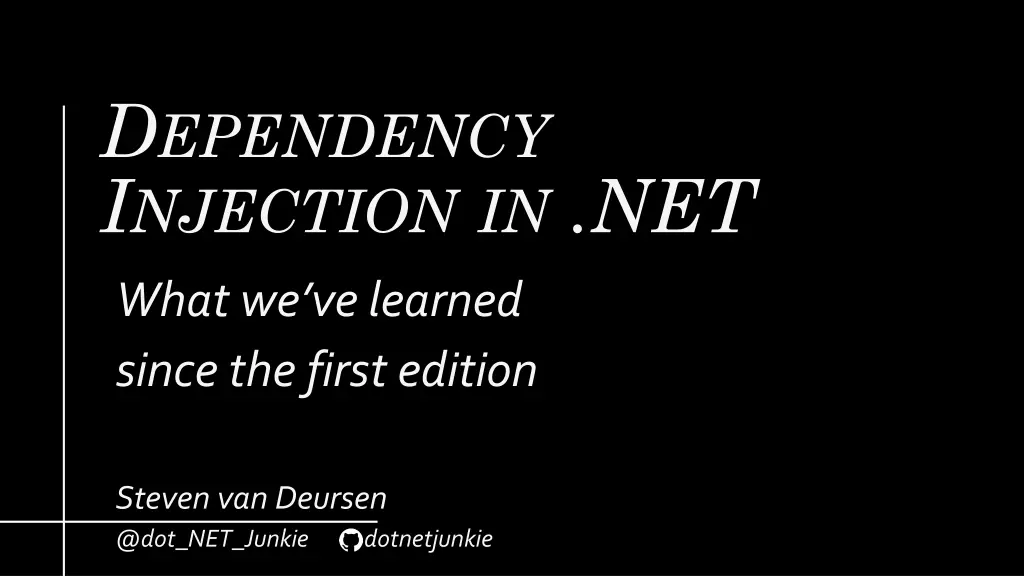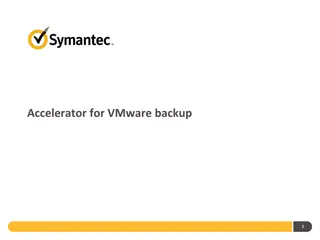
Dependency Injection in .NET Evolution: What We've Learned
Explore the evolution of Dependency Injection in .NET, reflecting on key concepts such as constructor injection, DI patterns, singleton vs. transient objects, anti-patterns to avoid, and managing volatile dependencies. Learn how stable dependencies are crucial in DI implementations to enhance system stability and maintainability.
Download Presentation

Please find below an Image/Link to download the presentation.
The content on the website is provided AS IS for your information and personal use only. It may not be sold, licensed, or shared on other websites without obtaining consent from the author. If you encounter any issues during the download, it is possible that the publisher has removed the file from their server.
You are allowed to download the files provided on this website for personal or commercial use, subject to the condition that they are used lawfully. All files are the property of their respective owners.
The content on the website is provided AS IS for your information and personal use only. It may not be sold, licensed, or shared on other websites without obtaining consent from the author.
E N D
Presentation Transcript
DEPENDENCY INJECTION IN .NET What we ve learned since the first edition Steven van Deursen @dot_NET_Junkie dotnetjunkie
DI landscape Constructor Injection DI Container Composition Root Pure DI Method Injection DI Patterns Object Composition Transient Property Injection DI Singleton Control Freak Lifetime Management DI Anti-patterns Captive Dependencies Service Locator Ambient Context Interception Code smells Decorators Constructor over-injection Dynamic Interception Abstract Factory AOP Cyclic Dependencies
What weve learned Ambient Context Compile-time weaving Abstract Factories
Stable A Service Dependencies + SomeMethod() vs. A Repository An Entity Volatile + Update(Entity) + Id : Guid Dependencies System.Guid + NewGuid() : Guid
Volatile Out-of-process resource Nondeterministic behavior Needs replacing, mocking, decoration, interception Dependencies
Volatile Databases Web services File systems Message queues Dependencies Out-of-process resources
Volatile System.Random Dependencies Guid.NewGuid System.DateTime.Now Nondeterministic Behaviour
Volatile Dependencies Replace, Mock, Decorate, Intercept
A dependency is stable when it s not volatile https://manning.com/seemann2
Volatile Dependencies are the focal point of DI. https://manning.com/seemann2
= Stable Dependency Boolean.Parse("true"); ? No Out-of-process Deterministic No replacing interface IBooleanParser { bool Parse(string value); }
= Volatile Dependency Dal.SqlProductRepository.GetById(id); ? Out-of-process Nondeterministic Needs replacing interface IProductRepository { Product GetById(Guid id); }
Stable Dependencies vs. Volatile Dependencies
AMBIENTCONTEXT Photo by Matheus Lira on Unsplash
Singleton + Instance: Singleton -Singleton()
public class CarEngine { private CarEngine() { } public static readonly CarEngine Instance = new CarEngine(); public void Start() { ... } public void Switch(Gear gear) { ... } } CarEngine = Volatile Dependency public class Car { public void DriveTo(Location location) { CarEngine.Instance.Switch(Gear.Neutral); CarEngine.Instance.Start(); ... } }
public abstract class CarEngine { public static CarEngine Instance { get; set; } = new RealCarEngine(); public abstract void Start(); public abstract void Switch(Gear gear); private class RealCarEngine : CarEngine { ... } } [Fact] public void DriveTo_starts_the_car_engine() { var engine = new FakeCarEngine(); CarEngine.Instance = engine; var car = new Car(); car.DriveTo(GetValidLocation()); Assert.True(engine.Started); }
An Ambient Context supplies application code outside the [application s entry point] with global access to a Volatile Dependency or its behavior by the use of static class members. https://manning.com/seemann2
An Ambient Context supplies application code [ ] with global access to a Volatile Dependency or its behavior by the use of static public abstract class CarEngine { public static CarEngine Instance { get; set; } = new RealCarEngine(); public abstract void Start(); public abstract void Switch(Gear gear); class members. ... }
Anti-pattern other documented solutions that prove to be more effective are [always] available
Controlling public class WelcomeMessageGenerator { public string GetWelcomeMessage() { DateTime now = DateTime.Now; string partOfDay = now.Hour < 6 ? "night" : "day"; return $"Good {partOfDay}."; } } time DateTime.Now = Volatile Dependency
Controlling public interface ITimeProvider { DateTime Now { get; } } time public static class TimeProvider { public static ITimeProvider Current { get; set; } }
Controlling public class WelcomeMessageGenerator { public string GetWelcomeMessage() { DateTime now = TimeProvider.Current.Now; string partOfDay = now.Hour < 6 ? "night" : "day"; return $"Good {partOfDay}."; } } time
Downsides public class WelcomeMessageGenerator { ... Dishonesty public string GetWelcomeMessage() { Some code here ... More code here ... All the way down here even more code ... Hidden dependency DateTime now = TimeProvider.Current.Now; string partOfDay = now.Hour < 6 ? "night" : "day"; return $"Good {partOfDay}."; } }
Downsides Increased Complexity
ITimeProvider + Now: DateTime Frozen Provider Default Provider - value: DateTime + Now: DateTime + Now: DateTime SomeController MessageGenerator + GetWelcomeMessage()
Downsides public class WelcomeMessageGenerator { private readonly ITimeProvider timeProvider = TimeProvider.GetCurrent( typeof(WelcomeMessageGenerator)); Increased Complexity public string GetWelcomeMessage() { DateTime now = timeProvider.Now; string partOfDay = now.Hour < 6 ? "night" : "day"; return $"Good {partOfDay}."; } }
Global state Downsides [Fact] public void Says_good_day_during_day_time() { // Arrange DateTime dayTime = DateTime.Parse("2019-01-01 6:00"); TimeProvider.Current = new FakeTimeProvider { Now = dayTime }; var generator = new WelcomeMessageGenerator(); // Act string actualMessage = generator.GetWelcomeMessage(); // Assert Assert.Equal("Good day.", actual: actualMessage); } Test Interdependency No Teardown
Fixing Ambient Context
Fixing Ambient Context public class WelcomeMessageGenerator { private readonly ITimeProvider timeProvider; public WelcomeMessageGenerator(ITimeProvider provider) { this.timeProvider = provider ?? throw new Exception(); } public string GetWelcomeMessage() { DateTime now = this.timeProvider.Now; string partOfDay = now.Hour < 6 ? "night" : "day"; return $"Good {partOfDay}."; } } Constructor Injection
AMBIENTCONTEXT She might seem easy to use, that doesn t make her healthy for you
Aspect-Oriented Programming aims to reduce boilerplate code required for implementing Cross-Cutting Concerns. https://manning.com/seemann2
Notify property changed public class Person { public string GivenNames { get; set; } public string FamilyName { get; set; } public string FullName => $"{GivenNames} {FamilyName}"; }
public class Person : INotifyPropertyChanged { private string givenNames; private string familyName; Notify property changed public event PropertyChangedEventHandler PropertyChanged; public string GivenNames { get => this.givenNames; set { if (value != this.givenNames) { this.givenNames = value; this.OnPropertyChanged(nameof(GivenNames)); this.OnPropertyChanged(nameof(FullName)); } } } by hand public string FamilyName { get => this.familyName; set { if (value != this.familyName) { this.familyName = value; this.OnPropertyChanged(nameof(FamilyName)); this.OnPropertyChanged(nameof(FullName)); } } } public string FullName => $"{this.GivenNames} {this.FamilyName}"; private void OnPropertyChanged(string name) { PropertyChanged?.Invoke(this, new PropertyChangedEventArgs(name)); } }
Notify property changed with tooling public class Person : INotifyPropertyChanged { public event PropertyChangedEventHandler PropertyChanged; public string GivenNames { get; set; } public string FamilyName { get; set; } public string FullName => $"{GivenNames} {FamilyName}"; }
public class SqlProductRepository : IProductRepository { private readonly CommerceContext context; Authorization public SqlProductRepository(CommerceContext context) { this.context = context; } [Authorize("Admin")] public void Insert(Product product) { this.context.Products.Add(product); } [Authorize("Admin")] public void Delete(Product product) { this.context.Products.Remove(product); } public Product[] GetProducts() ... }
[AttributeUsage(...)] [PSerializable] [MulticastAttributeUsage(...)] public class AuthorizeAttribute : OnMethodBoundaryAspect { private readonly string role; public AuthorizeAttribute(string role) { this.role = role; } public override void OnEntry(MethodExecutionArgs args) { var userContext = new WcfUserContext(); if (!userContext.IsInRole(this.role)) throw new SecurityException(); } Authorization public override void OnSuccess(...) public override void OnExit(...) public override void OnError(...) }
public class SqlProductRepository : IProductRepository { ... Authorization public void Insert(Product product) { var userContext = new WcfUserContext(); if (!userContext.IsInRole("Admin")) throw new SecurityException(); this.context.Products.Add(product); } public void Delete(Product product) { var userContext = new WcfUserContext(); if (!userContext.IsInRole("Admin")) throw new SecurityException(); this.context.Products.Remove(product); } public Product[] GetProducts() ... }
Compile-time weaving causes tight coupling https://manning.com/seemann2
public class SqlProductRepository : IProductRepository { ... Authorization public void Insert(Product product) { var userContext = new WcfUserContext(); if (!userContext.IsInRole("Admin")) throw new SecurityException(); this.context.Products.Add(product); } public void Delete(Product product) { var userContext = new WcfUserContext(); if (!userContext.IsInRole("Admin")) throw new SecurityException(); this.context.Products.Remove(product); } ... }
Compile-time weaving is the opposite of DI; it's a DI anti-pattern. https://manning.com/seemann2
Alternatives Dynamic Interception SOLID
Alternatives SOLID
Alternatives public interface ICommandHandler<TCommand> { void Handle(TCommand command); } SOLID CQRS






















